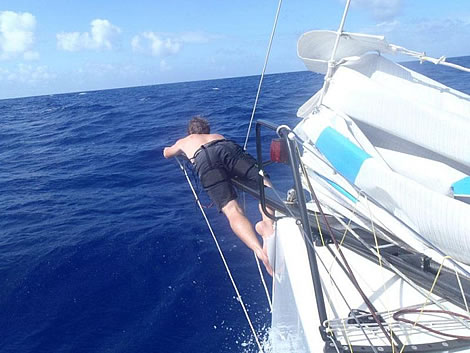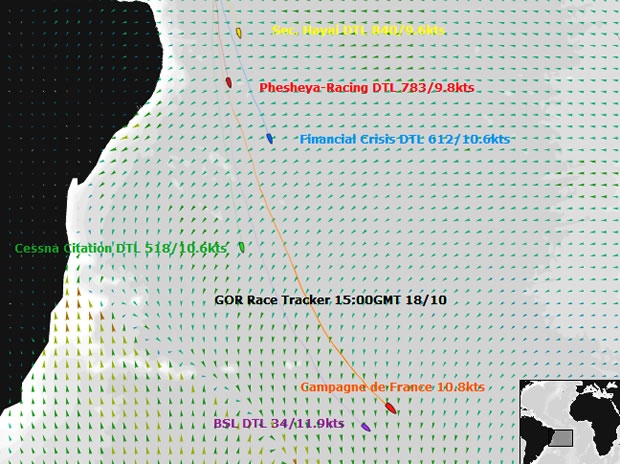Waiting for the door to slam shut
There is a very real sense of urgency in the double-handed Global Ocean Race fleet as the high-pressure system northeast of the Falklands continues to sprawl across the western side of the South Atlantic and threatens to slam the door on the majority of the Class40s.
At the front of the fleet, Campagne de France and BSL continue to hammer south in northeasterly breeze with Ross and Campbell Field finding the sweet spot on BSL early on Tuesday morning, picking up speed to over 12 knots and chiselling away relentlessly at the lead held by Halvard Mabire and Miranda Merron, reeling in Campagne de France by six miles under the cover of darkness and shadowing the leaders by 44 miles pre-dawn on Tuesday in increasingly harsh conditions.
North of the leaders by 460 miles, Conrad Colman and Hugo Ramon polled the highest speed averages overnight in third place peaking at 13 knots around midnight with their Akilaria RC2, Cessna Citation, sailing deep and west, 400 miles off the coast of Brazil. Marco Nannini and Paul Peggs – keeping the distance to Colman and Ramon steady at around 90 miles – were sailing slightly higher and slower in 16 knots of breeze on Financial Crisis in fourth place, but were averaging ten knots throughout Tuesday and getting some easting in the bank.
On the South African Class40, Phesheya-Racing in fifth place, Nick Leggatt and Phillippa Hutton-Squire encountered slightly lighter breeze south of Fernando de Noronha and have sailed deeper, keeping up the pace to just below ten knots, but dropping back 40 miles behind Nannini and Peggs in 24 hours and trailing Financial Crisis by 168 miles at 06:00 GMT on Tuesday. At 20:00 GMT on Monday, the Dutch duo of Nico Budel and Ruud van Rijsewijk in sixth with Sec. Hayai crossed the Fastnet Marine Insurance Scoring Gate and immediately hardened up, making between eight and nine knots and pushing to the southeast rather than dropping directly south.
Throughout Tuesday morning, race leader Campagne de France – further northeast and to windward of BSL – was the first to feel the breeze drop at around 05:00 GMT, while Ross and Campbell Field, 60 miles southwest of Mabire and Merron, kept up the pace averaging one knot faster than the Franco-British duo.
In the midday position poll on Tuesday, BSL was still eating the deficit, closing down to 37 miles behind Campagne de France.
Although Ross Field had no way of knowing, issues had appeared with typically poor timing on Campagne de France. Miranda Merron explains: “Our communications system decided to go on strike,” she confirms. Many hours spent on the handheld Iridium phone to the team’s service provider revealed there was no technical problem on the boat and no satellite connection fault. “The system eventually resolved its issues just after dark, but we spent all day in a total communication blackout trying to find a solution,” continues Merron. This left Mabire and Merron sailing without the usual three-hourly position reports or any capability to download weather information. “These are even more crucial when your competition has access to this information,” she adds.
While Mabire and Merron wrestled with technical issues, there was no opportunity to ease off with BSL on a roll. “The motion is pretty violent at the moment with a confused sea,” reported Halvard Mabire on Monday evening. “This isn’t the favourite angle for Campagne de France, but it’s a hot spot for the Kiwis and their Verdier-designed boat.” There is only one option: “We try to stay up in the 12 knots-range when we can and this means hand steering as Nestor [the autopilot] isn’t so good in the complicated wave pattern we have at the moment.” In fact, conditions were so harsh at the helm that Mabire and Merron were forced to wear their Guy Cotten survival suits: “You have to make sure every zip and seal is closed and we put it on with as much care and thoroughness as a medieval knight putting on armour before a jousting tournament.” Although the suit keeps the duo dry, the fire hose impact of the water is still intense: “We’re both also wearing skiing goggles to protect our eyes from the spray as it arrives with such force that it slaps you in the face leaving us momentarily stunned.”
Throughout Tuesday morning, Colman and Ramon were dropping south pushing Cessna Citation to the limit and continually polling averages of just under 14 knots for a period of five hours. However, the continued pressure produced some close calls with the jacket on the spinnaker tack line parting and pulling through the clutch causing – as Colman puts it - “much excitement”. Having repaired the jacket and secured the tack line with a couple of safety turns on a pit winch, Colman and Ramon retired to the back of the boat just as the Vectran tack line parted completely when Cessna Citation fell off a wave: “We quickly dropped our reaching spinnaker after becoming temporarily monosyllabic with each other and sought to solve the problem,” says Colman.

The tack line runs through the middle of the Akilaria RC2’s sophisticated carbon bowsprit and running a mouse line through the outboard end required some extreme acrobatics: “While tied on for security, it was a pretty precarious situation with my nose inches from the oncoming waves and the pole drooping alarmingly with my weight!” Colman explains. “We’re now back up and running at full speed, but looking somewhat nervously about for what will go BANG next!” Despite the dramatic action on board, the New Zealand-Spanish duo are still focused on the high-pressure system centred almost 2,000 miles SSW of Cessna Citation: “We’re pushing hard and are sailing reasonably fast in approximately the right direction, although the weather in front of us looks like a dog’s breakfast,” says Colman. “So, who knows where the right way is?” he asks.
Weather models suggest that Colman and Ramon will run into headwinds on Wednesday as Campagne de France and BSL, 500 miles to the southeast of Cessna Citation, will hang onto following breeze. “What does look certain is that the rich will continue to get richer as the front two boats may well avoid the top of the newly-forming high-pressure zone that we will surely have to beat over,” summarises Colman. “With protest marches in Wall Street about the behaviour of sticky fingered bankers, may I propose a little wealth redistribution over here too!”
In the 15:00 GMT position poll on Tuesday, BSL remains in marginally stronger breeze to the south of Campagne de France, making 12 knots and trailing Mabire and Merron by 34 miles. Colman and Ramon have now sustained solid averages of over 13 knots for seven hours while Nannini and Peggs in fourth with Financial Crisis, 94 miles north of Cessna Citation, have averaged just below 11 knots over the same period. Sailing 150 miles off the coast of Brazil, Nick Leggatt and Phillippa Hutton-Squire with Phesheya-Racing in fifth and Nico Budel and Ruud van Rijsewijk in sixth with Sec. Hayai are both averaging slightly under ten knots and separated by 57 miles.










Latest Comments
Add a comment - Members log in